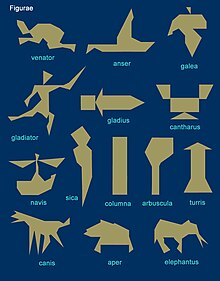Ostomachion
This section possibly contains original research. (October 2013) |



In ancient Greek geometry, the Ostomachion, also known as loculus Archimedius (from Latin 'Archimedes' box') or syntomachion, is a mathematical treatise attributed to Archimedes. This work has survived fragmentarily in an Arabic version and a copy, the Archimedes Palimpsest, of the original ancient Greek text made in Byzantine times.[1]
The word Ostomachion (Ὀστομάχιον)[2] comes from Greek ὀστέον (osteon) 'bone', and μάχη (mache) 'fight, battle, combat'.[3][4] The manuscripts refer to the word as "Stomachion", an apparent corruption of the original Greek. Ausonius gives us the correct name "Ostomachion" (quod Graeci ostomachion vocavere, "which the Greeks called ostomachion").
The Ostomachion which he describes was a puzzle similar to tangrams and was played perhaps by several persons with pieces made of bone.[5] It is not known which is older, Archimedes' geometrical investigation of the figure, or the game. Victorinus,[6] Bassus[7] Ennodius[8] and Lucretius[9] have also discussed the game.
Game
The game is a 14-piece dissection puzzle forming a square. One form of play to which classical texts attest is the creation of different objects, animals, plants etc. by rearranging the pieces: an elephant, a tree, a barking dog, a ship, a sword, a tower etc. Another suggestion is that it exercised and developed memory skills in the young. James Gow, in his Short History of Greek Mathematics (1884), footnotes that the purpose was to put the pieces back in their box, and this was also a view expressed by W. W. Rouse Ball in some intermediate editions of Mathematical Essays and Recreations, but edited out from 1939.
The number of different ways to arrange the parts of the Stomachions within a square were determined to be 17,152 by Fan Chung, Persi Diaconis, Susan P. Holmes, and Ronald Graham, and confirmed by a computer search by William H. Cutler.[10] However, this count has been disputed because surviving images of the puzzle show it in a rectangle, not a square, and rotations or reflections of pieces may not have been allowed.[11]
References
- ^ Darling, David (2004). The universal book of mathematics: from Abracadabra to Zeno's paradoxes. John Wiley and Sons, p. 188. ISBN 0-471-27047-4
- ^ ὀστομάχιον, Henry George Liddell, Robert Scott, A Greek-English Lexicon, on Perseus Digital Library
- ^ ὀστέον, Henry George Liddell, Robert Scott, A Greek-English Lexicon, on Perseus Digital Library
- ^ μάχη, Henry George Liddell, Robert Scott, A Greek-English Lexicon, on Perseus Digital Library
- ^ Ausonii Cento nuptialis in Monumenta Germaniae Historica, auctores antiquissimi, vol. 5, part 2: D. Magni Ausonii opuscola, Berolini apud Weidmannos, 1883, pagg. 140-41 Archived 2015-09-23 at the Wayback Machine.
- ^ Ars grammatica, III, 1 in Grammatici latini, Lipsiae in aedibus R. G. Teubneri, 1857, vol. 6, part 1, pagg. 100-01.
- ^ De metris, 9 in Grammatici latini cit., pagg. 271-72,
- ^ Carmen CCCXL (2, 133) in Monumenta Germaniae Historica, auctores antiquissimi, vol. 7, Magni Felicis Ennodi opera, Berolini apud Weidmannos, 1885, pag. 249 Archived 2016-03-06 at the Wayback Machine
- ^ De rerum natura, II, 776-787 cited in Netz, Reviel; Acerbi, Fabio; Wilson, Nigel (2004). "Towards a reconstruction of Archimedes' Stomachion" (PDF). Sciamvs. 5: 67–99. Archived from the original (PDF) on 4 October 2013. Retrieved 3 October 2013.
- ^ Kolata, Gina (December 14, 2003), "In Archimedes' Puzzle, a New Eureka Moment", The New York Times
- ^ Huxley, G. L. (Winter 2009), "Review of Ludic Proof: Greek Mathematics and the Alexandrian Aesthetic", Hermathena, 187: 116–121, JSTOR 23317530
Further reading
- J. L. Heiberg, Archimedis opera omnia, vol. 2, pp. 420 ff., Leipzig: Teubner 1881
- Reviel Netz & William Noel, The Archimedes Codex (Weidenfeld & Nicolson, 2007)
- J. Väterlein, Roma ludens (Heuremata - Studien zu Literatur, Sprachen und Kultur der Antike, Bd. 5), Amsterdam: Verlag B. R. Grüner bv 1976
External links
- Heinrich Suter, Loculus
- James Gow, Short History
- W. W. R. Ball, Recreations and Essays
- The Ostomachion at the Bibliotheca Augustana
- Ostomachion, a Graeco-Roman puzzle
- Professor Chris Rorres
- Kolata, Gina. "In Archimedes' Puzzle, a New Eureka Moment." The New York Times. December 14, 2003
- A tour of Archimedes' Stomachion, by Fan Chung and Ronald Graham.
- Ostomachion and others tangram Play with 38 Tangram games online: more than 7,300 shapes proposed by the program.

